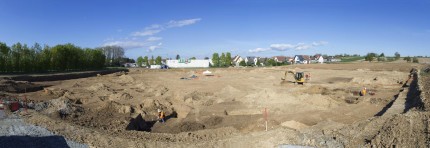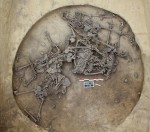 Archaeologists from France’s National Institute for Preventative Archaeology (INRAP) have unearthed the skeletal remains of a Neolithic massacre in a silo in Achenheim, Alsace, northeastern France. The silo is pit number 124 of more than 300 used to store grain and other food staples unearthed inside a large Neolithic compound surrounded by a V-sectioned ditch with defensive bastions at the entrances. The silos were only used for food storage temporarily. Once they were emptied, they were used as garbage dumps or graves. The compound dates to between 4400 and 4200 B.C., a turbulent time in Alsace which explains why the settlement needed extensive protective measures.
Archaeologists from France’s National Institute for Preventative Archaeology (INRAP) have unearthed the skeletal remains of a Neolithic massacre in a silo in Achenheim, Alsace, northeastern France. The silo is pit number 124 of more than 300 used to store grain and other food staples unearthed inside a large Neolithic compound surrounded by a V-sectioned ditch with defensive bastions at the entrances. The silos were only used for food storage temporarily. Once they were emptied, they were used as garbage dumps or graves. The compound dates to between 4400 and 4200 B.C., a turbulent time in Alsace which explains why the settlement needed extensive protective measures.
 Silo 124 is one of the larger pits at almost 2.5 meters (8.2 feet) in diameter and it was set apart from the other silos either on the site of a dwelling or in a residential area. Inside the silo archaeologists found the complete skeletons of six people, five adult males and one teenage male between 15 and 19 years of age. The fact that the six complete skeletons were all male indicates this may have been a group of warriors, or at least defenders of the settlement. They were found lying on their back, stomach and sides, sometimes intermingled. The position of the bodies indicates they were dumped in the pit and no further attention was paid to them. They were not buried with the care evinced in other silo graves; these bodies were disposed of, pure and simple.
Silo 124 is one of the larger pits at almost 2.5 meters (8.2 feet) in diameter and it was set apart from the other silos either on the site of a dwelling or in a residential area. Inside the silo archaeologists found the complete skeletons of six people, five adult males and one teenage male between 15 and 19 years of age. The fact that the six complete skeletons were all male indicates this may have been a group of warriors, or at least defenders of the settlement. They were found lying on their back, stomach and sides, sometimes intermingled. The position of the bodies indicates they were dumped in the pit and no further attention was paid to them. They were not buried with the care evinced in other silo graves; these bodies were disposed of, pure and simple.
 All six of the skeletons have numerous broken bones. There are fractures on the legs, hands, feet, ribs, collar bones, skulls and mandibles. The fractures were on living bone, and the extent and quantity of the broken bones suggest they were brutally beaten to death with blows from a stone axe. The wounds are too extensive to have been received in combat. This was a methodical punishment inflicted off the battlefield on helpless individuals.
All six of the skeletons have numerous broken bones. There are fractures on the legs, hands, feet, ribs, collar bones, skulls and mandibles. The fractures were on living bone, and the extent and quantity of the broken bones suggest they were brutally beaten to death with blows from a stone axe. The wounds are too extensive to have been received in combat. This was a methodical punishment inflicted off the battlefield on helpless individuals.
The violence wasn’t just perpetrated on the living bodies, but on their corpses as well. Post-mortem wounds were also found on the bones. The corpses were all put in the silo at the same time, meaning they likely died in the same event, a single episode of killing in a larger conflict.
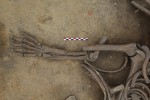 In addition to the complete skeletons, archaeologists found the upper left arms of three adults and the left forearm of a youth 12 to 16 years old. The forearm was cut in the middle of the humerus. The arms are believed to be “war trophies.” It’s not possible from osteological examination to determine the sex of the people’s whose arms were severed and thrown into the silo, nor were archaeologists able to discern whether the arms were severed pre or post-mortem.
In addition to the complete skeletons, archaeologists found the upper left arms of three adults and the left forearm of a youth 12 to 16 years old. The forearm was cut in the middle of the humerus. The arms are believed to be “war trophies.” It’s not possible from osteological examination to determine the sex of the people’s whose arms were severed and thrown into the silo, nor were archaeologists able to discern whether the arms were severed pre or post-mortem.
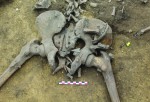 The severed left arms are reminiscent of another very similar massacre discovered in Bergheim, 35 miles southwest of Achenheim. In 2012, archaeologists found the skeletons of eight individuals, also tossed in a silo and who also died in a single event. Under the complete skeletons at the bottom of the pit were seven left upper arms. The Achenheim and Bergheim date to the same period, the Middle Neolithic.
The severed left arms are reminiscent of another very similar massacre discovered in Bergheim, 35 miles southwest of Achenheim. In 2012, archaeologists found the skeletons of eight individuals, also tossed in a silo and who also died in a single event. Under the complete skeletons at the bottom of the pit were seven left upper arms. The Achenheim and Bergheim date to the same period, the Middle Neolithic.
(INRAP archaeologists also found skeletal remains in an ancient silo about 70 miles west of Achenheim in the Lorraine town of Marsal. Eight skeletons, two of them children, were discovered tossed haphazardly over each other in the silo, but they were much more recent, dating to around 500 B.C.)
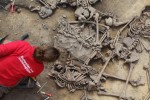 Archaeologists think both the Achenheim and Bergheim massacres could have been the result of raid by locals against newcomers to the area, or a victory by locals against raiders from elsewhere. The victory was celebrated with torture and mutilation of enemy prisoners. Pottery discovered on the site indicates the residents were part of the Bruebach-Oberbergen culture, but that pottery is followed by ceramic shards in a style first made in Paris.
Archaeologists think both the Achenheim and Bergheim massacres could have been the result of raid by locals against newcomers to the area, or a victory by locals against raiders from elsewhere. The victory was celebrated with torture and mutilation of enemy prisoners. Pottery discovered on the site indicates the residents were part of the Bruebach-Oberbergen culture, but that pottery is followed by ceramic shards in a style first made in Paris.
 Archaeologists would like to do stable isotope analysis on the bones to find out where the individuals were born and raised. If they were from the Paris area, that would mean they were killed by the fierce local farmers defending their homes and supplies from raiders. If they were local boys, they were likely the victims of a successful raid. INRAP will need to raise money to fund the additional research, however, as they don’t have the budget for it now.
Archaeologists would like to do stable isotope analysis on the bones to find out where the individuals were born and raised. If they were from the Paris area, that would mean they were killed by the fierce local farmers defending their homes and supplies from raiders. If they were local boys, they were likely the victims of a successful raid. INRAP will need to raise money to fund the additional research, however, as they don’t have the budget for it now.
